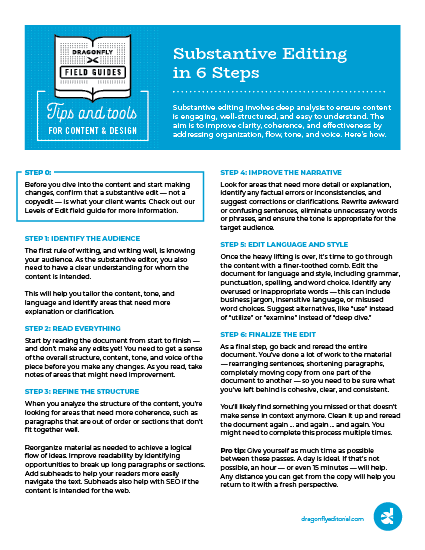Substantive editing involves deep analysis of material to ensure content is engaging, well-structured, and easy to understand. The aim is to improve clarity, coherence, and effectiveness by addressing organization, flow, tone, and voice. Here’s how to begin.
Step 0
Before you dive into the content and start making changes, confirm that a substantive edit — not a copyedit — is what your client wants. Check out our Levels of Edit field guide for more information.
Step 1: Identify the Audience
The first rule of writing, and writing well, is knowing your audience. As the substantive editor, you also need to have a clear understanding for whom the content is intended.
This will help you tailor the content, tone, and language and identify areas that need more explanation or clarification.
Step 2: Read Everything
Start by reading the document from start to finish — and don’t make any edits yet! You need to get a sense of the overall structure, content, tone, and voice of the piece before you make any changes. As you read, take notes of areas that might need improvement.
Step 3: Refine the Structure
When you analyze the structure of the content, you’re looking for areas that need more coherence, such as paragraphs that are out of order or sections that don’t fit together well.
Reorganize material as needed to achieve a logical flow of ideas. Improve readability by identifying opportunities to break up long paragraphs or sections. Add subheads to help your readers more easily navigate the text. Subheads also help with SEO if the content is intended for the web.
Step 4: Improve the Narrative
Look for areas that need more detail or explanation, identify any factual errors or inconsistencies, and suggest corrections or clarifications. Rewrite awkward or confusing sentences, eliminate unnecessary words or phrases, and ensure the tone is appropriate for the target audience.
Step 5: Edit Language and Style
Once the heavy lifting is over, it’s time to go through the content with a finer-toothed comb. Edit the document for language and style, including grammar, punctuation, spelling, and word choice. Identify any overused or inappropriate words — this can include business jargon, insensitive language, or misused word choices. Suggest alternatives, like “use” instead of “utilize” or “examine” instead of “deep dive.”
Step 6: Finalize the Edit
As a final step, go back and reread the entire document. You’ve done a lot of work to the material — rearranging sentences, shortening paragraphs, completely moving copy from one part of the document to another — so you need to be sure what you’ve left behind is cohesive, clear, and consistent.
You’ll likely find something you missed or that doesn’t make sense in context anymore. Clean it up and reread the document again … and again … and again. You might need to complete this process multiple times.
Pro tip: Give yourself as much time as possible between these passes. A day is ideal. If that’s not possible, an hour — or even 15 minutes — will help. Any distance you can get from the copy will help you return to it with a fresh perspective.


